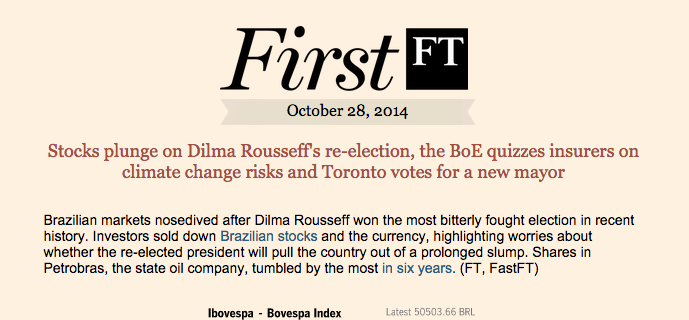
With email newsletters, what’s old is new again. Alongside their tumultuous love affair with traffic from social networks, publishers are also reinvesting in using email to hold onto their more dedicated readers. Email may not be the sexiest way to reach audiences, but it works.
“There’s still a very strong appetite for email,” said Andrew Jack, head of aggregation and curated content at The Financial Times, which launched its latest daily newsletter, FirstFT, last week. “People want something that’s always there and easy to access. It also gives us a way to push news and comments to readers in a new form.”
But while many publishers are reinvesting in newsletters, they aren’t all going about it in the same way. Some publishers think that the newsletter is a place for aggregation, while others maintain that it’s a home for their own content. Publishers also vary as to when they send their newsletters out, and how much they tweak their presentation for readers.
Here’s the tale of the tape for a handful of the newer and more popular newsletters.
Quartz’s Daily Brief

The pitch: “We wanted the newsletter to feel like a personal email from a savvy, intelligent, well-connected person giving you a take on the important things going on in the world,” said Quartz senior editor Gideon Lichfield.
The content mix: Quartz’s Daily Brief includes links to articles not only from Quartz but other publishers as well. Lichfield said the goal was to push the newsletter as a service to readers, not just a way to get people back to Quartz itself. That’s a stance that’s increasingly in vogue.
Key metrics: Launched in September 2012, The Daily Brief has 95,000 subscribers, with an open rate of 41 percent for its North American edition, according to Lichfield.
Monetization: Quartz’s newsletters are both sponsored and include native ad placements from brands. Previous advertisers include Comcast, Lincoln and Siemens. “It’s not a huge money-maker, but it certainly pays for itself,” Lichfield said.
Optimization tactics: While everyone who gets Quartz’s newsletter receives the same version of it, Quartz tweaks the newsletter’s delivery time based on which time zone readers say they’re in (Americas, Europe and Africa and Asia). The newsletter is sent out at 6 a.m. each day local time.
Vox’s Sentences

The pitch: “Vox Sentences is the fastest way to get caught up on the most important news stories after a long day, while also getting the context necessary to understand why they’re important,” according to Vox’s special projects editor Dylan Matthews.
Vox’s newsletter offers a slight twist on the newsletter formula: While most publishers are sending their newsletters early in the morning, Vox’s newsletter goes out closer to 8 p.m. Matthews said that Vox went with the move because the morning newsletter space was too saturated, though the site is open to experimenting with other send times as well.
The content mix: Most of the roughly 30 articles linked to by Vox Sentences comes from other publishers, not Vox itself. “The goal is to create a product that synthesizes important news stories for busy people in a highly readable manner,” Matthews said. “If people come to Vox in the process, so much the better, but that’s not the primary purpose of the newsletter.”
Key metrics: Vox didn’t share data about how many people are subscribed to the newsletter, or what its open rate is so far.
How it’s monetized: Vox monetizes its newsletter via standard banner placements.
Optimization tactics: While Vox isn’t A/B testing its newsletter now, Matthews says the site plans to do a lot of experimentation with content optimization down the line.
The Financial Times’s FirstFT

The pitch: Aimed at global decision-makers, FirstFT is a morning briefing that details the most important news in global finance, policy and politics.
The content mix: FirstFT falls neatly in the aggregation camp. Of the 15 to 20 stories linked to in its newsletter, only about half are written by the Financial Times. itself. “We have a strong commitment to showcase the best of the rest of the Web, not just Financial Times content,” said Andrew Jack.
How it’s monetized: While The Financial Times sells FastFT ad spots, the real business case for the newsletter is to drive more people to subscribe to Financial Times content. Jack said that by building a relationship with non-paying readers, the Financial Times can make a stronger case for why those readers should pay up. “We want people to see that The Financial Times can provide essential information of the day to those decision-makers,” he said.
Key metrics: Because FirstFT is only a week old, The Financial Times said it was too early to share subscriber numbers or open rates.
Optimization tactics: While The Financial Times hasn’t experimented with extensive A/B testing with FastFT, it does offer a slightly different version of its FirstFT newsletter depending on which time zone readers say they’re in. Subscribers for the FastFT Americas, for example, get a tweaked version of the earlier FastFT Europe newsletter with fresher stories more relevant to their location.
Time.com’s “The Brief”

The pitch: The Brief, Time.com’s, newsletter, is a daily snapshot of Time’s content meant to keep people informed by the day’s biggest news. The newsletter’s goal is to get people coming back to Time on a regular basis, not necessarily to be a major money maker in its own right. “We’re trying to make Time a daily or hourly experience,” said Time.com managing editor Edward Felsenthal.
Content Mix: Each edition of The Brief includes links to 12 stories, all of which are from Time Inc’s own properties, making it the only publisher in this roundup that keeps things in-house.
Key metrics: Time’s newsletter reaches 650,000 people, with a 40 percent open rate.
How it’s monetized: Time uses the newsletter to both run ads and push readers to subscribe to its magazine.
Optimization tactics: Felsenthal said Time is still in the “early days” of tweaking and personalizing Time’s newsletter based on reader habits. Time’s newsletter goes out at 7 a.m. EST, though Time.com is experimenting with sending it earlier.
More in Media

The accidental guardian: How Cloudflare’s Matthew Prince became publishing’s unexpected defender
Cloudflare’s day job is fending off botnets and nation-state cyberattacks, not debating how Google and other AI firms crawl publisher sites.

A timeline of the major deals between publishers and AI tech companies in 2025
Here’s a list of all the major deals signed between publishers and AI tech companies in 2025.

No playbook, just pressure: Publishers eye the rise of agentic browsers
For the bulk of publishers, Google is, as ever, the one to watch. It’s already got agentic features within its Chrome browser, but that’s the tip of the iceberg, some say.





